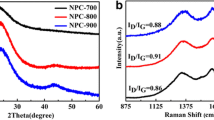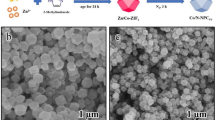Abstract
The Zn/Fe@N-doped porous graphitic carbon catalyst (Zn/Fe@PCN) was successfully produced through one-step pyrolysis of g-C3N4 and Zn/Fe-MOF and was used for the activation of persulfate (PS) for the degradation of RhB. The Zn/Fe@PCN/PS system was able to degrade 95.92% of RhB in 30 min at a rate of 0.6453 min−1 when RhB was concentrated at 50 mg L−1. The efficient degradation of RhB is primarily realized through the synergistic activation of PS by Zn, Fe, and N to produce reactive oxygen species 1O2, \(\cdot{\mathrm{O}}_2^-\), \(\cdot \mathrm{SO}_4^-\), and ·OH. Zn0/Fe0 in Zn/Fe@PCN forms a galvanic cell with carbon to release electrons to join in the activation of PS. The doping of Zn not only provides sufficient electrons for the activation of PS but also promotes the effective reduction of Fe2+ and thus the Fe2+/Fe3+ cycle. The N doping accelerates the electron transfer during the reaction progress.











Similar content being viewed by others
References
Amirache L, Barka-Bouaifel F, Borthakur P, Das MR, Ahouari H, Vezin H, Barras A, Ouddane B, Szunerits S, Boukherroub R (2021) Cobalt sulfide-reduced graphene oxide: an efficient catalyst for the degradation of rhodamine B and pentachlorophenol using peroxymonosulfate. J Environ Chem Eng 9(5):106018
Azhar MR, Arafat Y, Khiadani M, Wang S, Shao Z (2020) Water-stable MOFs-based core-shell nanostructures for advanced oxidation towards environmental remediation. Compos Part B Eng 192:107985
Cui Y, Zhou Z, Gao Y, Lei L, Cao J, Wu R, Liang L, Huang Z (2021) Energy saving intermittent electro-Fenton system combined with commercial MoS2 for effective Rhodamine B degradation. J Clean Prod 289:125807
Duan X, Ao Z, Zhou L, Sun H, Wang G, Wang S (2016a) Occurrence of radical and nonradical pathways from carbocatalysts for aqueous and nonaqueous catalytic oxidation. Appl Catal B- Environ 188:98–105
Duan X, Sun H, Ao Z, Zhou L, Wang G, Wang S (2016b) Unveiling the active sites of graphene-catalyzed peroxymonosulfate activation. Carbon 107:371–378
Duan P, Qi Y, Feng S, Peng X, Wang W, Yue Y, Shang Y, Li Y, Gao B, Xu X (2020) Enhanced degradation of clothianidin in peroxymonosulfate/catalyst system via core-shell FeMn @ N-C and phosphate surrounding. Appl Catal B- Environ 267:118717
Fang G, Liu C, Gao J, Dionysiou DD, Zhou D (2015) Manipulation of persistent free radicals in biochar to activate persulfate for contaminant degradation. Environ Sci Technol 49:5645–5653
Fu H, Du ZJ, Zou W, Li HQ, Zhang C (2013) Simple fabrication of strongly coupled cobalt ferrite/carbon nanotube composite based on deoxygenation for improving lithium storage. Carbon 65:112–123
Gao Y, Li T, Zhu Y, Chen Z, Liang J, Zeng Q, Lyu L, Hu C (2020) Highly nitrogen-doped porous carbon transformed from graphitic carbon nitride for efficient metal-free catalysis. J Hazard Mater 393:121280
Guan C, Jiang J, Luo C, Pang S, Yang Y, Wang Z, Ma J, Yu J, Zhao X (2018) Oxidation of bromophenols by carbon nanotube activated peroxymonosulfate (PMS) and formation of brominated products: comparison to peroxydisulfate (PDS). Chem Eng J 337:40–50
Lai B, Zhou Y, Qin H, Wu C, Pang C, Lian Y, Xu J (2012a) Pretreatment of wastewater from acrylonitrile–butadiene–styrene (ABS) resin manufacturing by microelectrolysis. Chem Eng J 179:1–7
Lai L, Potts JR, Zhan D, Wang L, Poh CK, Tang C, Gong H, Shen Z, Lin J, Ruoff RS (2012b) Exploration of the active center structure of nitrogen-doped graphene-based catalysts for oxygen reduction reaction. Energ Environ Sci 5:7936–7942
Lei Y, Sun W, Tiwari SK, Thummavichai K, Ola O, Qin X, Ma Z, Wang N, Zhu Y (2021) Zn/Co-ZIF reinforced sugarcane bagasse aerogel for highly efficient catalytic activation of peroxymonosulfate. J Environ Chem Eng 9:106885
Li X, Cui K, Guo Z, Yang T, Cao Y, Xiang Y, Chen H, Xi M (2020) Heterogeneous Fenton-like degradation of tetracyclines using porous magnetic chitosan microspheres as an efficient catalyst compared with two preparation methods. Chem Eng J 379:122324
Li X, Zhang W, Liu Z, Wang S, Zhang X, Xu B, Yu P, Xu Y, Sun Y (2022) Effective removal of tetracycline from water by catalytic peroxymonosulfate oxidation over Co@MoS2: catalytic performance and degradation mechanism. Sep Purif Technol 294:121139
Li W, Nie C, Wang X, Ye H, Li D, Ao Z (2023) Alkaline lignin-derived N-doped biochars as peroxymonosulfate activators for acetaminophen degradation: performance and catalytic bridging mediated electron-transfer mechanism. Sep Purif Technol 323:124418
Liang J, Fu L (2021) Activation of peroxymonosulfate (PMS) by Co3O4 quantum dots decorated hierarchical C@Co3O4 for degradation of organic pollutants: Kinetics and radical-nonradical cooperation mechanisms. Appl Surf Sci 563:150335
Lin L, Zhu Q, Xu AW (2014) Noble-metal-free Fe–N/C catalyst for highly efficient oxygen reduction reaction under both alkaline and acidic conditions. JACS 136:11027–11033
Liu Y, Fan Q, Wang J (2018a) Zn-Fe-CNTs catalytic in situ generation of H2O2 for Fenton-like degradation of sulfamethoxazole. J Hazard Mater 342:166–176
Liu Y, Guo H, Zhang Y, Cheng X, Zhou P, Zhang G, Wang J, Tang P, Ke T, Li W (2018b) Heterogeneous activation of persulfate for Rhodamine B degradation with 3D flower sphere-like BiOI/Fe3O4 microspheres under visible light irradiation. Sep Purif Technol 192:88–98
Liu P, Zhong DJ, Xu YL, Zhong NB, He GJ (2021) Co/Fe co-doped porous graphite carbon derived from metal organic framework for microelectrolysis-Fenton catalytic degradation of Rhodamine B. J Environ Chem Eng 9:105924
Liu P, Zhong DJ, Xu YL, Zhong NB (2022) Nitrogen doped Cu/Fe@PC derived from metal organic frameworks for activating peroxymonosulfate to degrade Rhodamine B. J Environ Chem Eng 10:107595
Liu Y, Zhong D, Xu Y, Chang H, Dong L, Han Z, Li J, Zhong N (2023) Facile synthesis of lanthanum-doped Fe-based MOF for phosphate removal from water: high adsorption capacity, tuneability, and reproducibility. Water Air Soil Pollut 234:321
Ma J, Jia N, Shen C, Liu W, Wen Y (2019) Stable cuprous active sites in Cu(+)-graphitic carbon nitride: structure analysis and performance in Fenton-like reactions. J Hazard Mater 378:120782
Ma T, Liu M, Li T, Ren H, Zhou R (2022) Nitrogen-doped carbon nanotubes derived from carbonized polyaniline as a robust peroxydisulfate activator for the oxidation removal of organic pollutants: singlet oxygen dominated mechanism and structure-activity relationship. Sep Purif Technol 293:121124
Pang YL, Abdullah AZ (2013) Current status of textile industry wastewater management and research progress in malaysia: a review. Clean-Soil Air Water 41:751–764
Peng L, Duan X, Shang Y, Gao B, Xu X (2021) Engineered carbon supported single iron atom sites and iron clusters from Fe-rich Enteromorpha for Fenton-like reactions via nonradical pathways. Appl Catal B-Environ 287(15):119963
Piumetti M, Fino D, Russo N (2015) Mesoporous manganese oxides prepared by solution combustion synthesis as catalysts for the total oxidation of VOCs. Appl Catal B-Environ 163:277–287
Ren W, Nie G, Zhou P, Zhang H, Duan X, Wang S (2020) The intrinsic nature of persulfate activation and N-doping in carbocatalysis. Environ Sci Technol 54:6438–6447
Shang Y, Chen C, Zhang P, Yue Q, Li Y, Gao B, Xu X (2019) Removal of sulfamethoxazole from water via activation of persulfate by Fe3C@NCNTs including mechanism of radical and nonradical process. Chem Eng J 375:122004
Shang YN, Xing X, Yue Q, Gao B, Li Y (2020) Nitrogen-doped carbon nanotubes encapsulating Fe/Zn nanoparticles as a persulfate activator for sulfamethoxazole degradation: role of encapsulated bimetallic nanoparticles and nonradical reaction. Environ Sci Nano 7:1444–1453
Sharma J, Mishra IM, Kumar V (2015) Degradation and mineralization of Bisphenol A (BPA) in aqueous solution using advanced oxidation processes: UV/H2O2 and UV/S2O82− oxidation systems. J Environ Manage 156:266–275
Wang L, Yang Q, Wang D, Li X, Zeng G, Li Z, Deng Y, Liu J, Yi K (2016) Advanced landfill leachate treatment using iron-carbon microelectrolysis- Fenton process: process optimization and column experiments. J Hazard Mater 318:460–467
Wang Y, Cao D, Zhao X (2017) Heterogeneous degradation of refractory pollutants by peroxymonosulfate activated by CoOx-doped ordered mesoporous carbon. Chem Eng J 328:1112–1121
Wang H, Guo W, Liu B, Wu Q, Luo H, Zhao Q, Si Q, Sseguya F, Ren N (2019) Edge-nitrogenated biochar for efficient peroxydisulfate activation: an electron transfer mechanism. Water Res 160:405–414
Wen G, Wang SJ, Ma J, Huang TL, Liu ZQ, Zhao L, Su JF (2014) Enhanced ozonation degradation of di-n-butyl phthalate by zero-valent zinc in aqueous solution: performance and mechanism. J Hazard Mater 265:69–78
Wu Y, Wang L, Jin M, Kong F, Qi H, Nan J (2019) Reduced graphene oxide and biofilms as cathode catalysts to enhance energy and metal recovery in microbial fuel cell. Bioresource Technol 283:129–137
Xu Y, Hu E, Xu D, Guo Q (2021) Activation of peroxymonosulfate by bimetallic CoMn oxides loaded on coal fly ash-derived SBA-15 for efficient degradation of Rhodamine B. Sep Purif Technol 274:119081
Yang Z, Ma Y, Liu Y, Li Q, Zhou Z, Ren Z (2017) Degradation of organic pollutants in near-neutral pH solution by Fe-C micro-electrolysis system. Chem Eng J 315:403–414
Yang J-j, Wang J-l, Li H, Deng Y-r, Chen Y, Zhao Q, Dang Z (2022) Nitrogen-doped biochar as peroxymonosulfate activator to degrade 2,4-dichlorophenol: preparation, properties and structure–activity relationship. J Hazard Mater 424:127743
Ye Z, Padilla JA, Xuriguera E, Brillas E, Sirés I (2020) Magnetic MIL(Fe)-type MOF-derived N-doped nano-ZVI@C rods as heterogeneous catalyst for the electro-Fenton degradation of gemfibrozil in a complex aqueous matrix. Appl Catal B-Environ 266:118604
Zhang J, Wu Y, Liu L, Lan Y (2015) Rapid removal of p-chloronitrobenzene from aqueous solution by a combination of ozone with zero-valent zinc. Sep Purif Technol 151:318–323
Zhang BT, Zhang Y, Teng Y (2018) Electrospun magnetic cobalt–carbon nanofiber composites with axis-sheath structure for efficient peroxymonosulfate activation. Appl Surf Sci 452:443–450
Zhang H, Li G, Deng L, Zeng H, Shi Z (2019a) Heterogeneous activation of hydrogen peroxide by cysteine intercalated layered double hydroxide for degradation of organic pollutants: performance and mechanism. J Colloid Interface Sci 543:183–191
Zhang Y, Zhang N, Wang T, Huang H, Chen Y, Li Z, Zou Z (2019b) Heterogeneous degradation of organic contaminants in the photo-Fenton reaction employing pure cubic Β-Fe2O3. Appl Catal B Environ 245:410–419
Zhang XW, Wang F, Wang CC, Wang P, Fu H, Zhao C (2021) Photocatalysis activation of peroxodisulfate over the supported Fe3O4 catalyst derived from MIL-88A(Fe) for efficient tetracycline hydrochloride degradation. Chem Eng J 426(15):131927
Zhou H, Lv P, Shen Y, Wang J, Fan J (2013) Identification of degradation products of ionic liquids in an ultrasound assisted zero-valent iron activated carbon micro-electrolysis system and their degradation mechanism. Water Res 47:3514–3522
Zhou X, Xu D, Chen Y, Hu Y (2020) Enhanced degradation of triclosan in heterogeneous E-Fenton process with MOF-derived hierarchical Mn/Fe@PC modified cathode. Chem Eng J 384:123324
Zhu K, Jin C, Zhao C, Hu R, Klencsár Z, Ayyakannu SG, Srankó DF, Ge R, Wang J (2019) Modulation synthesis of multi-shelled cobalt-iron oxides as efficient catalysts for peroxymonosulfate-mediated organics degradation. Chem Eng J 359:1537–1549
Funding
This work was supported by financial supports from the National Natural Science Foundation of China (No. 52176178) and the Innovation Research Group of Universities in Chongqing (No. CXQT21035), the Action Plan for High Quality Development of Graduate Education of Chongqing University of Technology (Grant gzltd202204), and Innovation research team incubation program of Chongqing University of Technology (2023TDZ005) are gratefully acknowledged.
Author information
Authors and Affiliations
Contributions
DZ: project administration, resources, supervision, and resources. PL: conceptualization, formal analysis, investigation, methodology, software, validation, and writing—original draft. YL: formal analysis and software. YX: formal analysis, supervision, validation, visualization, and writing—review and editing.
Corresponding author
Ethics declarations
Ethical approval
Not applicable.
Consent to participate
Not applicable.
Consent to publish
Not applicable.
Competing Interests
The authors declare no competing interests.
Additional information
Responsible Editor: Guilherme Luiz Dotto
Publisher's Note
Springer Nature remains neutral with regard to jurisdictional claims in published maps and institutional affiliations.
Rights and permissions
Springer Nature or its licensor (e.g. a society or other partner) holds exclusive rights to this article under a publishing agreement with the author(s) or other rightsholder(s); author self-archiving of the accepted manuscript version of this article is solely governed by the terms of such publishing agreement and applicable law.
About this article
Cite this article
Zhong, D., Liu, P., Liu, Y. et al. Nitrogen-doped Zn/Fe@PCN derived from metal–organic frameworks activating persulfate to efficiently degrade rhodamine B. Environ Sci Pollut Res 31, 2228–2242 (2024). https://doi.org/10.1007/s11356-023-31174-4
Received:
Accepted:
Published:
Issue Date:
DOI: https://doi.org/10.1007/s11356-023-31174-4




